As an Amazon Associate I earn from qualifying purchases.
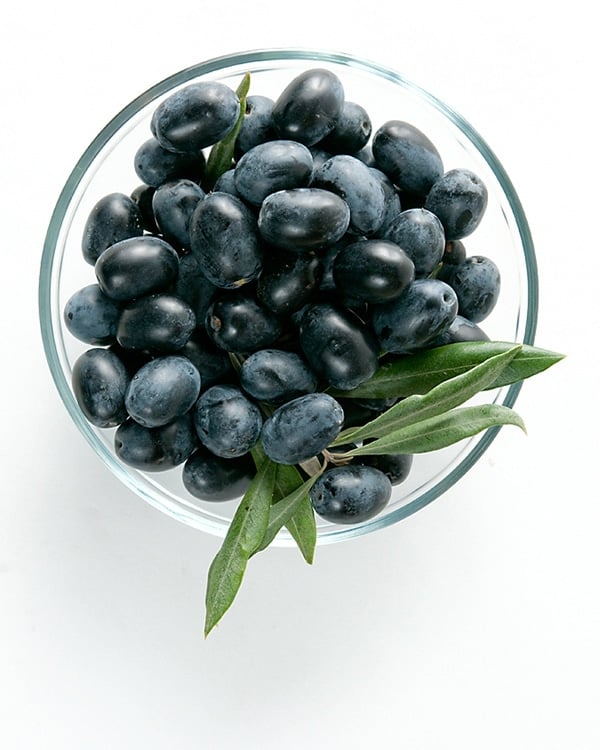
Here in Northern California, olive trees grow all over the place. And every autumn since 2004, I’ve gathered green olives from a park near my house to make batches of brine-cured olives and lye-cured olives. Each have their place on my table. Black olives come later.
I like the typical black kalamata-style olive, but don’t love them. What I prefer are those wrinkly oil-cured black olives. Fortunately, you make them with very ripe olives, which means late January or February here in NorCal.
Black olives will hang on the tree for months, and as it rains, they get less and less bitter. If you can catch some very late, as in early spring, you can kinda-sorta eat them off the tree.
Olive fly is a scourge on our local trees. The flies lay eggs on the olives and the larvae burrow into the olive, leaving a tell-tale scar that looks like someone branded the side of the olive with a hot pinhead.

Normally I have to toss every third or fourth green olive, picking my way through to the clean ones. But late-season black olives are almost completely free of larvae.
I can’t be certain, but what I think happened is that throughout the long winter, all the olives infected with the parasite had already dropped off the trees; rotten olives surrounded each one. By March, all that was left were good ones.
On a good day I can gather about three pounds’ worth of black olives in no time.
Five weeks later, you will have fantastic oil-cured black olives. In fact, I don’t think anyone ought to pick black olives before February. In three pounds of olives, I typically have maybe 20 infected with olive fly. And the months of weathering on the tree — all that chilling and rain — had already leached out some of the bitterness from the olives.
And they are beautiful. They look like they ought to be delicious right off the tree. Sadly, they aren’t. Edible, but only barely. The good news is that oil-curing is just about the easiest method of curing olives. Once you’ve picked through all the olives to remove any with olive fly larvae scars, you only need three things to do this:
- A pillowcase or other sack
- Salt (kosher or pickling or cheap sea salt)
- Time.
How much salt? You don’t need to be exact. A good ratio is about 1 pound of kosher salt to 2 pounds of fresh black olives. You can go a little over or under this if you’d like, but err on the side of more salt, not less. Pour the salt into the pillowcase, then the olives, and mix them all around so the olives are covered.
Hang the pillowcase somewhere that black, dripping olive juice won’t matter. I hung the case between the two sheds in our backyard. Yep, that’s right: You can do this outside. Weather doesn’t matter, and some sources say the cure is even better of everything gets rained on once in a while.
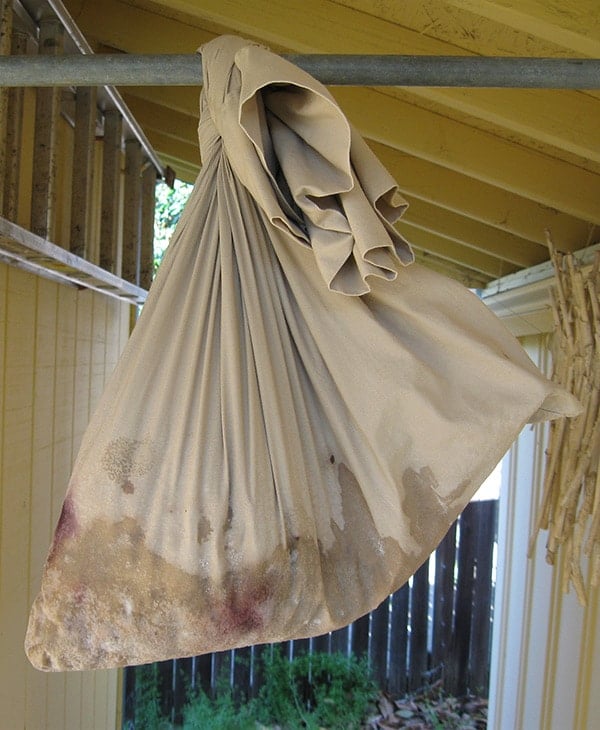
Attend to your olives once a week or so, to mix them around again and make sure they are still well-covered in salt. The earliest they might be ready is a month, but they should definitely be cured by six weeks.
After a month, take one out. The olive should look wrinkly, taste salty and be just a little bitter. These olives will always be more bitter than those done by the lye-curing method. I like that little hit of bitterness. Take them out of the salt when they are “sweet” enough for you, or after six weeks, whichever comes first.
You will notice something. No oil. While these olives are known to one and all as “oil-cured,” they are not actually cured in oil at all. They are cured in salt. The oil comes next.
I made 3 pounds of these olives, far more than I could reasonably eat in a normal amount of time. And while they look mummified, these olives are quite perishable. Left alone at room temperature, the oils in the olives will begin to turn rancid in a month or two. In the fridge, however, they will last a year if you store them properly. Here’s how:
- Arrange the cured olives in one layer on a cookie sheet and allow to dry overnight. Sometimes a little olive juice gets on them during the curing process, and you want this to evaporate before you put the olives in for long-term storage.
- When they’ve dried overnight, mix the olives with about 1/2 pound of salt for every 4 to 5 pounds of cured olives. Store in an airtight container.
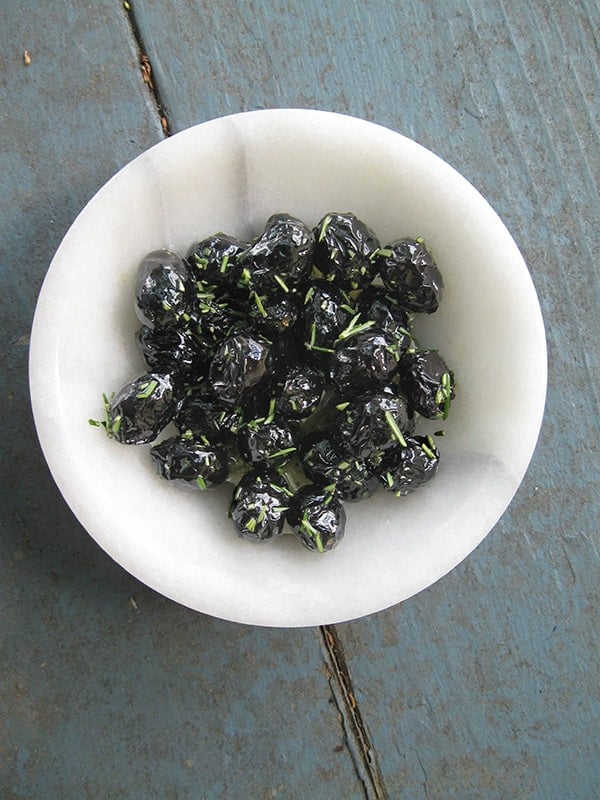
When you want to eat them, some sources say to boil the salted olives for a few seconds to remove some of the saltiness. Boiling will also plump up the olives a little. You don’t have to do this, as the olives are excellent either way. What you do need is marinate them in olive oil for at least a day. This is where the oil-cured part comes in.
You can completely submerge your cured olives in oil, or just coat them in it. Your choice. Definitely include a chopped fresh herb such as rosemary, sage, thyme or oregano. A little lemon zest would be nice, as would some cumin or black pepper. But don’t gussy up these olives too much. Their allure is in their simple, briny richness.
Once marinated, eat the olives within a few weeks or so.


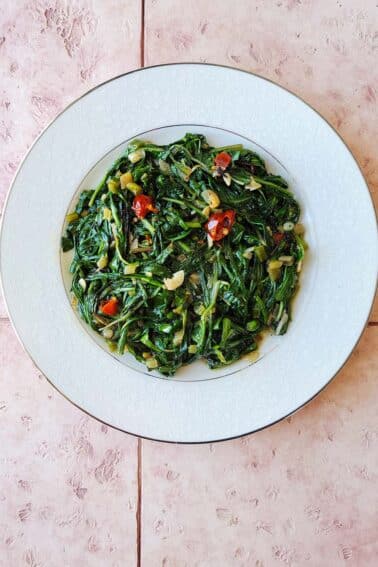
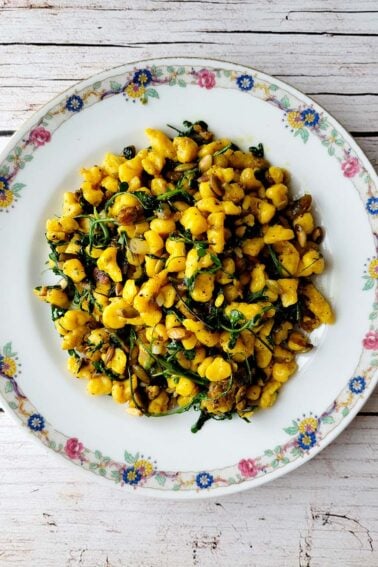
I have several containers full of salt and olives right now. In one, the olives have changed color,faded quite a bit. Have you ever seen this.. I assume something is wrong.
I made these for several years but after cure, idumped them into a plastic trash can and covered them with olive oil and put a lid on it. They lasted at least 2 or three years then I’d do it over again
Hi Hank! Thanks for all the info. To make sure I’m clear, you need to marinate the olives before eating them, no matter what the method of storage? Is there a way to store them besides salted in the fridge?
Cassandr: No, you could eat them salty. They’ll be OK to eat, but not to my liking. I’ve only ever stored them salted in a cool place.
Hi Hank, I’m planning on attempting this; however I live up in Canada and 6 weeks from now will take us to December – there is a possibility that we will get a hard frost before then. Do you know if this is something I have to be concerned about?
Eric: You mean the hanging in the pillowcase part? Yeah, don’t let them freeze too hard. Put them in the garage with a basin underneath to catch any droppings.
Hello Hank,
Which method do you recommend for black olives from Southern California (LA) ?
Caroline: Are they black now? Use this method.
I just picked three big jars of green olives and we are water bathing them for the 4 weeks you suggested. The black olives off the same tree need curing though so I will try the salt in a bag method. Thanks for helping our two trees are covered this year?
Joanne: Way too early for oil cured olives. You need to wait until winter for that.
Thank you for a great recipe.. June and I will try it..
We done ours in jars but not sure if we should remove the water build up in the bottom it’s only been a week and more and more water is building up in the jar from the olives , should we remove the liquid?
Kenny: Yes, remove the liquid.
Hi Hank,
Thank you for sharing your knowledge. I’m an olive novice got a great big load soaking in water, now about 10 days. Will soak them next in the brine. Wish me luck.
Very informative, thank you! Will this method be ok for Kalamata olives that still have a hint of green to them?
Kate: I generally only do this method with fully ripe olives.
Thank you
Hi, I found your article really interesting. My husband and I love black kalamon olives and they’re being sold in the local market in abundance. Thanks to you I’m going to try and preserve some. Fingers crossed!
Hi! I love your article about oil curing olives. I’ve just picked my first handful of olives ever! They are wrinkly & black, & some wrinkly green. I’d love to read about your other methods for lessening the overly bitterness in fresh picked olives , or as I’m learning, curing them. Also, I wonder, why does one need to discard the olives with the fly egg wound? Does it make them inedible or incurable, or is the flesh of the olive way less delicious? Thank you so much again for your lovely post!!
I’ve done green and black olives for 20 yrs. here in CT. I’ve learned my techniques from my wine/capocollo, mentor That grew up on a farm in Italy. With the green we make a brine of enough salt to float 2 eggs( just in-case one egg is bad), add 1 gallon of white vinegar, 24 garlic cloves, 24 hot peppers. Keeping all the olives submerged with a wreath of fresh fennel ferns, wait 6 months. When ready I remove the seasonings and store in sealed 5 gal. bucket on concrete basement floor( stays 60 to 58 degrees)next to my wine.
On ripe black olives I use 2 5 gallon buckets inner one has holes in it and holds the salted olives.I wash, pierce holes in olives with a toothpick, layer in holed bucket with abundant kosher salt. Toss the olives around in the bucket every 2 days with more salt for about 2.5 weeks, poking holes in the olives speeds the curing. When they are done to your liking wash salt off and let air dry for a day. save what you want in olive oil with any seasoning you might like. Garlic hot pepper flakes, rosemary,citrus, what ever. Experiment with different small batches, keep notes. Put the rest on a cookie sheet and freeze. The next day put frozen olives in zip-lock , store in the freezer. You can fry or grill to defrost and store in olive oil mix of your liking. ENJOY
About ten years ago, a wealthy landowner living on 500+ acre property below us planted seven acres of olive tree slips in a meadow just off the road leading up to our house. At the time, the trees were only about 24 inches tall. They grew for the next three years as a drip system was installed to water them. Soon after, however, the landowner sold his property, and the new corporate landowner decided he didn’t like the little olive trees there. He decided to rip out the now 3-4 feet tall olive trees. My wife and I drove by the property one Friday November afternoon on our way home from work, and witnessed a man in a tractor digging up all the trees! I pulled over, waved the man down and asked him why he was pulling out the olive trees. As I mentioned before, his boss didn’t like them. I asked him if I could have some of them. He called the landowner, and asked if I could take some of the newly ripped out trees. He finished his conversation with the landowner, then told me he was stopping for the weekend, but said I could have as many as I wanted, but had to finish taking the trees by Sunday as the remaining trees would be ripped out, hauled away and destroyed. I immediately jumped into action!
I called a landscaper friend of mine who gave me 125 black heavy duty plastic 5 gallon planting pots. I called my two grown sons to come over and give me a hand, and in one day, we dug up and placed 90 trees into those pots. I put all of the trees in a location where I could tend them, gave each a shot of vitamin B-1 for root shock, water, and Miracle Gro because I was thinking it was going to be a miracle if those trees could withstand the beating they took! One year later, 87 of the 90 trees survived and took root in the pots.
The trees have been in the ground now for a little over six years, and for the first time, produced about 30 lbs. of round, marble-sized olives. I don’t know what variety they are. I didn’t have enough olives to pay a local winery and olive orchardist to mash the olives into olive oil with their huge granite wheels, but certainly had enough to make your lye-cured and oil-cured olives following your recipes. You are right–they are like Lay’s Potato Chips–you can’t eat just one! Thanks for the recipes!
–Frank Balestrieri
our local imam is from morocco, he told me of the salt cure, but not the lye cure, I just planted two trees, I figure that’ll be enough for me, are the olives pressed or what to get the oil?
These salt cured olives packed in olive oil will last for at least a year if stored in a cool place out of sunlight. No need to refrigerate either. More recipes for fresh olives
http://www.dosaguilasoil.com
Very helpful dried oil method! I work at The Olive Hut in Tehama County CA. We have so many local fresh olives/processed stuffed olives available. We are in the process of now curing our own version of the “dried Greek olives” Again very helpful, thank you:)
BTW, If anyone has trouble finding fresh olives for home cure, we at the Olive Hut are able to ship fresh green or black olives anywhere in the United States.
I have had a look at everyone’s ideas and comments. In Hawkes Bay, NZ we are known as fruit bowl country there isn’t a lot here that we can’t grow in the way of fruit and veg. I have my own olive tree and this is my first year giving cured olives a go, I have chosen to go with the pillow case idea, when I bought the tree I had no idea that you even have to cure olives, only had to try one straight off the tree. The pillow case is now hanging out side looking forward to seeing the results.
My folks leave theirs in the pantry, but I put mine in the fridge and let them come to room temp, just like cheese, before eating. Also, In Italy, a lot of times people will dress them with extra virgin olive oil, garlic, hot peperoncino, and maybe an herb, such as fennel or fennel pollen, or dried oregano, or fresh rosemary, etc. And always a hunk of really good Parmesan!